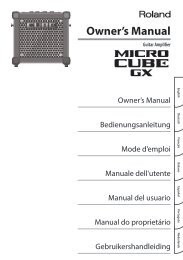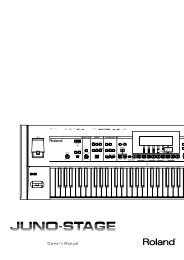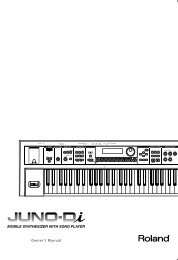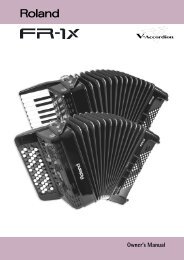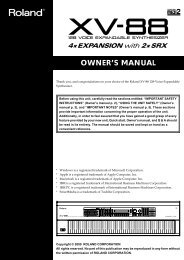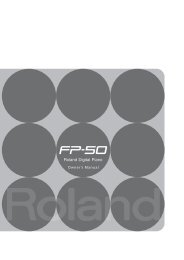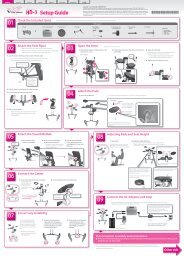Create successful ePaper yourself
Turn your PDF publications into a flip-book with our unique Google optimized e-Paper software.
Chapter 3. About the D-FIELD<br />
Changing the rhythmic feel of a pattern (ASSIGN 2: QUANTIZE)<br />
fig.QTE—<br />
You can change the rhythm feel of the performance data of a pattern. By modifying the timing and velocity (volume) of the notes<br />
in the pattern, you can produce a rhythm feel that is different than that of the original pattern.<br />
fig.Quantize<br />
You can modify the note timing by the location at which you press the D-FIELD.<br />
When TYPE is set to “GROOVE,” you can also modify the velocity by pressing a higher or lower location.<br />
Display Explanation Setting<br />
TYPE Select the type of quantization. OFF, GRID, SHUFFLE, GROOVE<br />
X none Timing Timing (fixed)<br />
Y none Velocity (Only when the type is set to “GROOVE.”) Velocity (fixed)<br />
➔ Changing the D-FIELD settings (p. 22)<br />
Making detailed settings<br />
1. Hold down [ASSIGN 2] and press [EDIT].<br />
2. Press [ENTER] to select the desired parameter.<br />
3. Turn [VALUE] to change the setting.<br />
Display Parameter Explanation Setting<br />
When TYPE is “GRID”<br />
TYPE Select the type of quantization. OFF:<br />
Quantize will not be applied.<br />
GRID:<br />
The note timing of the pattern will be corrected toward<br />
the note value specified by the template setting.<br />
SHUFFLE:<br />
The timing of the backbeats of the pattern will be<br />
adjusted to create a “bouncy” feel as in shuffle or<br />
swing.<br />
GROOVE:<br />
The note timing and velocity of the pattern will be<br />
adjusted toward the values specified by the template,<br />
producing a variety of different grooves.<br />
TEMPLATE Specify the note value to which the timing<br />
will be aligned.<br />
32, 16T, 16, 8T, 8, 4T, 4<br />
TIMING Specify the strength of the correction. Higher<br />
settings will cause the timing to be corrected<br />
more precisely (tightly).<br />
When TYPE is “SHUFFLE”<br />
TEMPLATE Specify the note value to which the timing<br />
will be aligned.<br />
TIMING Adjust the amount of swing. With a setting of<br />
“50,” there will be no sense of swing at all.<br />
Normally, a setting in the range of 60–66 will<br />
produce a pleasant shuffle rhythm.<br />
When TYPE is “GROOVE”<br />
TEMPLATE Select the template. *The templates are for a<br />
4/4 time signature. The desired result will not<br />
be obtained for other time signatures.<br />
TIMING Specify the strength of the timing correction.<br />
Higher settings will cause the timing to be adjusted<br />
closer to the timing of the template.<br />
VELOCITY Specify the strength of the velocity correction.<br />
Higher settings will cause the velocity to be<br />
adjusted closer to the velocity of the template.<br />
0–100<br />
16, 8<br />
0–100<br />
1–71<br />
* Refer to “List of GROOVE templates” on next<br />
page.<br />
0–100<br />
0–100<br />
37<br />
Chapter 3



